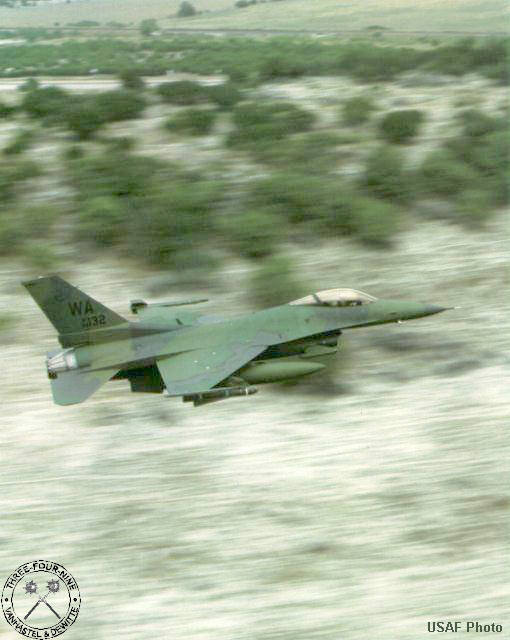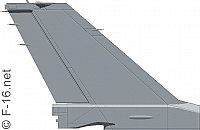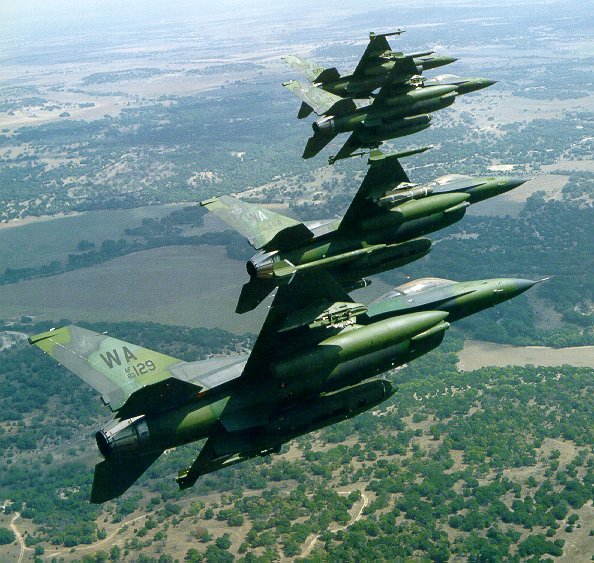A-16 Close Air Support
In the 1980's, the USAF started setting aside F-16s for the planned A-16 modification, a dedicated close air support version of the F-16. In 1989, the designation block 60 was reserved for the A-16. The A-16 Block 60 was to be equipped with a 30 mm cannon and provided with a strengthened wing structure for anti-tank weapons such as 7.62 mm min pods. This project failed because the 30 mm gun would heat up and senge the inner components of the left fuselage.
There were two block 15's that were converted to this modification; they were based at Shaw airforce base. The Block 60 did not go into production and the A-16 became wrapped up in the debate about close air support. The supporters of the A-16 project wanted the USAF to replace its A-10A Thunderbolt IIs with A-16's, arguing that the A-10 was too slow to survive above a high-tech battlefield. Detractors argued that the A-16 had insufficient range and load-carrying capability to make an effective attack aircraft, and, in addition, it would be too vulnerable to enemy anti-aircraft fire.
The Army argued that the Key West agreement of 1948 (under which they were prohibited from operating fixed-wing combat aircraft) was now obsolete, and that the USAF's A-10's should be turned over to them for use alongside AH-64 Apache helicopters. In 1990, Congress decreed that some USAF A-10A's and OV-10 Broncos be turned over to the Army and Marine Corps beginning in 1991.
However, all of these plans came to naught on November 26th, 1990, when the USAF was ordered to retain two wings of A-10 aircraft for the CAS mission. No order for the A-16 was ever placed.
F/A-16 block 30
On the same November 26th, 1990, when the USAF was forced to opt for the A-10 in stead of the A-16, the decision was made to retrofit up to 400 existing Block30/32 F-16C/D's with new equipment to perform the CAS (close Air Support) and BAI (Battlefield Air Interdiction) missions, effectively killing the A-16 program. Modifications would include a Global Positioning System (GPS), Digital Terrain System (DTS), system hardening, modular mission computer, and an Automatic Target Handoff System (ATHS).
A prototype Block 30 (although still with the A-model HUD and the slim tail base) was based at Shaw AFB and went through numerous physical adjustments. Official designation, much like the Hornet, was to be F/A-16. In January 1992, this plan too was abandonned in favor of using LANTIRN-equipped Block40/42 F-16C/D's.
F/A-16A & F/A-16C

The USAF was rather reluctant to let the idea of a dedicated CAS F-16 go, and planned to replace its A-10's with F-16s fitted with a version of the Warthog's Avenger cannon. In November 1988, the 174th TFW of the New York ANG began transitioning from the A-10A Thunderbolt II to the F-16A/B block 10, becoming the first unit to operate the F-16 in a close air support role.
During Desert Storm, their 24 F-16A/B aircraft were equipped to carry the General Electric GPU-5/A Pave Claw pod on the centerline station. The pod houses a 30mm GAU-13/A four-barrel derivative of the seven-barrel GAU-8/A cannon used by the A-10A, and 353 rounds of ammunition. The aircraft received the new designation F/A-16, and were the only F-16s ever to be equipped with this weapon, intended for use against a variety of battlefield targets, including armor.
If the tests were successful, there were plans for a fleet of F/A-16C's with the same armament. To demonstrate the concept, the AF installed Pave Penny avionics, 30mm gun pods and European One paint jobs on 7 F-16C's (#83128, -129, -130, -131, -132, -144, -267). F-16B no. 2 (#75752) was given similar treatment except for a Falcon Eye system. These aircraft flew from Nellis with the 'WA' tailcode.
The F-16s from the 174th were deployed to the Persian Gulf during Desert Storm, but the project proved to be a miserable failure. Precision aiming was impossible for several reasons:
- The pylon mount isn't as steady as the A-10's rigid mounting;
- The F-16 flies much faster than an A-10, giving the pilots too little time approaching the target;
- Firing the gun shook the aircraft harshly and made it impossible to control;
- Essential CCIP (continuously computed impact point) software was unavailable.
The F/A-16C plan was quietly forgotten. The USAF still has plans to replace the A-10 with F-16s, but they no longer involve 30mm gun pods (or, apparently, a designation with an "A" in it).
Sources
- Lt. Carl Krittenden
In the fall of 1989 I was out at Ft. Walters Texas (an hour or so west of Ft Worth) driving around in an M-60A3 tank belonging the 49th armor division. I was there to play target to the A-16 in a series of hide and seek games. Our tank was suppose to find a nice hiding place in the dark and scan the skies with the TTS (tank thermal sight). We were suppose to get a sooting solution with a simulated proximity det beehive (flachette) round before GD's Chief Test Pilot (the late Joe-Bill Dryden) could find and lock in on us with Falcon Eye. In 10 out of 10 exercises he found us first. Most of the time we didn't see him until he literally blocked out the stars above us. After his pass we were able to maintain lock on him until he interposed a terrain feature (the aft section of an f-16 shows up quite nicely on Far-IR).
Besides the new camo and falcon-eye the a-16 had 1 other striking difference from its stable mates.....armor. It had kevlar laminate backed by light metallic matrix. This was installed under the skin around the crew compartment flight control computer and compressor.
What this little exercise proved was that a highly skilled pilot can glide in on a target at mach .95 (with the engine throttled back to idle for noise reduction) and acquire a hidden ground target at night before the target acquire him. After the exercise controller called it quits Bill put on a little impromptu air show and then flew back to GD Ft. Worth /Carswell AFB (Now Ft Worth Joint Use Reserve Base).
Shadow Blade
Even if the implementation hadn't been so half-arsed (seriously, no CCIP?), recoil would've probably still been excessive. A more rational solution would've been to create a gunpod for the Oerlikon KCA revolver cannon, which uses the same 30x173mm ammo. It's got half the ROF of the GAU-13/A, but it'd surely be a lot more accurate. Might even be viable to mount such a gun internally (as on the Saab Viggen) replacing the M61A1 Vulcan, though with its longer barrel it would probably extend outside of the fuselage. A moot point since the USAF has abandoned the notion of a 30mm armed Viper, but oh well.
Please use this form to add any list any error or omissions you find in the above text.
Note: your comments will be displayed immediately on this page. If you wish to send a private comment to the webmasters, please use the Contact Us link.


